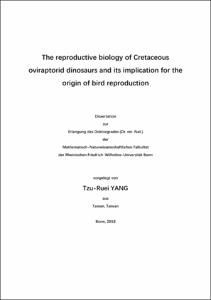The reproductive biology of Cretaceous oviraptorid dinosaurs and its implication for the origin of bird reproduction

The reproductive biology of Cretaceous oviraptorid dinosaurs and its implication for the origin of bird reproduction

| dc.contributor.advisor | Sander, Martin P. | |
| dc.contributor.author | Yang, Tzu-Ruei | |
| dc.date.accessioned | 2020-04-25T13:03:14Z | |
| dc.date.available | 2020-04-25T13:03:14Z | |
| dc.date.issued | 13.11.2018 | |
| dc.identifier.uri | https://hdl.handle.net/20.500.11811/7664 | |
| dc.description.abstract | This dissertation aims to pioneer an integrative approach that includes all lines of evidence to comprehensively and in detail reconstruct the biology of an extinct animal. Specifically, the dissertation consists of several contributions to understanding the reproductive biology of oviraptorid dinosaurs. Oviraptorid dinosaurs are a distinctive group of feathered maniraptoran dinosaurs from the Late Cretaceous and are characterized by their toothless, parrot-like beaks. They constitute Oviraptorosauria together with Caenagnathidae. Oviraptorid dinosaurs left a superb record of skeletal fossils, clutches, and eggs that inform on their reproductive biology. For instance, an oviraptorosaurian pelvis with a pair of shelled eggs inside elucidated their intermediate stage of ovulation and oviduct function between crocodiles and birds. The endothermy inferred from bone histology and discoveries of feathered dinosaurs in the last decades demonstrated that dinosaurs were closely related to modern birds. The association of an oviraptorid adult "sitting" on a clutch is represented by several Mongolian and Chinese fossils and was interpreted as brooding behavior, a parental care mode only present in modern birds. Despite controversies over this interpretation, these amazing fossils led to the current view that the biology of these near-bird dinosaurs can be inferred from that of modern birds. However, evidence from chemical, taphonomic, and ecological approaches presented in this dissertation reveals a unique reproductive biology in oviraptorid dinosaurs. Raman spectrometry, elemental mapping, chemometric analysis, and mass spectrometry indicate the preservation of cuticle on eggshell and tetrapyrrolic pigments in eggshell, suggested that the oviraptorid egg was cuticle-coated and its shell was blue-greenish in color. In addition to the colored eggshell, heterogeneous distribution of porosity over the egg indicates a semi-buried clutch. The investigation of several well-preserved oviraptorid clutches reveals that he oviraptorid clutch consists of three to four rings of paired eggs, the blunt end of which points to the center devoid of eggs in an inclining angle of more than 40 degrees. In ovo oviraptorid embryos at different developmental stages from the same clutch suggested hatching asynchrony, which was possibly a result of communal nesting and polygamy. All of these lines of evidence demonstrate a unique reproductive mode in oviraptorid dinosaurs that differs from modern birds in egg structure, clutch architecture and nesting mode, and from less derived dinosaurs and crocodiles in hatching mode and parental investment. Such a unique reproductive mode lacking any modern analogs is contrary to the current view that the nesting biology of these near-bird dinosaurs is analogous to that of modern birds since they are closely related. | en |
| dc.language.iso | eng | |
| dc.rights | In Copyright | |
| dc.rights.uri | http://rightsstatements.org/vocab/InC/1.0/ | |
| dc.subject.ddc | 560 Paläontologie | |
| dc.title | The reproductive biology of Cretaceous oviraptorid dinosaurs and its implication for the origin of bird reproduction | |
| dc.type | Dissertation oder Habilitation | |
| dc.publisher.name | Universitäts- und Landesbibliothek Bonn | |
| dc.publisher.location | Bonn | |
| dc.rights.accessRights | openAccess | |
| dc.identifier.urn | https://nbn-resolving.org/urn:nbn:de:hbz:5n-52465 | |
| ulbbn.pubtype | Erstveröffentlichung | |
| ulbbnediss.affiliation.name | Rheinische Friedrich-Wilhelms-Universität Bonn | |
| ulbbnediss.affiliation.location | Bonn | |
| ulbbnediss.thesis.level | Dissertation | |
| ulbbnediss.dissID | 5246 | |
| ulbbnediss.date.accepted | 08.10.2018 | |
| ulbbnediss.institute | Mathematisch-Naturwissenschaftliche Fakultät : Fachgruppe Erdwissenschaften / Steinmann-Institut für Geologie, Mineralogie und Paläontologie | |
| ulbbnediss.fakultaet | Mathematisch-Naturwissenschaftliche Fakultät | |
| dc.contributor.coReferee | Griebeler, Eva Maria |
Files in this item
This item appears in the following Collection(s)
-
E-Dissertationen (4465)




